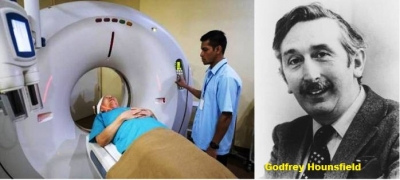
A CAT scan or CT scan is a special X-ray test that produces cross-sectional or three-dimensional images of different sections of the body. The acronym ‘CAT’ stands for ‘Computerized Axial Tomography’.
The invention of computers sparked researchers to try to combine X-rays with computer technology. In 1972, a British biomedical engineer named Sir Godfrey Hounsfield, developed the CAT scan. He received the Nobel Prize in 1979 for his work.
The first clinical CT scanners began to be installed in 1974. The original systems were dedicated to taking images of the head only, but ‘whole body’ systems became available in 1976. CT scans became widely available by about 1980.
The first CT scanner took several hours for a single scan and took days to reconstruct a single image from raw data. Today, an entire chest CT of 40 slices and 8mm thickness, can be scanned in 5 to 10 seconds using the most advanced multi-slice CT system.
During its 25-year history, CT has made great improvements in speed, patient comfort and resolution. CT scanners are now used to take pictures of any part of the body and are invaluable to medical diagnosis.
Picture Credit : Google




